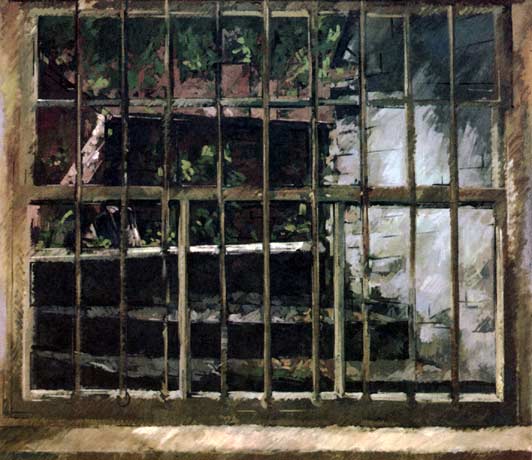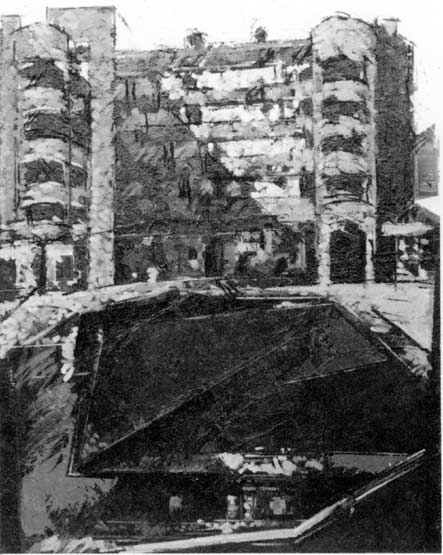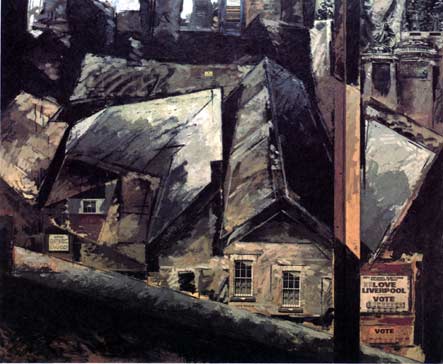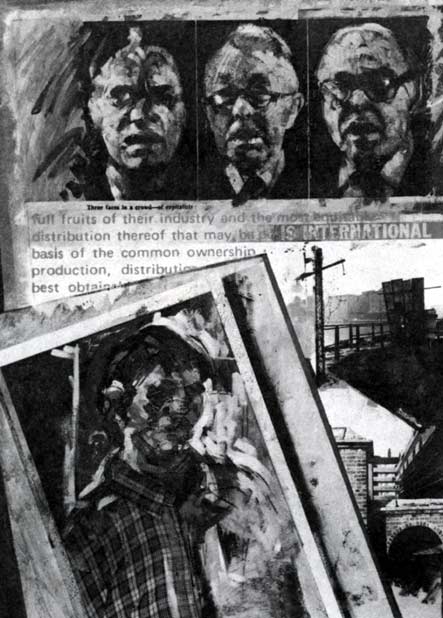Project
2
- Constructed Views Liverpool Painting: A Social Landscape
Rochdale
Art Gallery 25th February -24th March 1984 Pete Clarke's
activity as an artist has interested us for a long time.
He is a 'founder member' of the Liverpool artists' workshop,
evidence of a new and exciting move by artists to determine
their own structures and to effect grass root links with
the public. As a committed member of the Labour Party, he
is actively engaging in the the political struggles of Liverpool
and is trying to find new ways in which art can effectively
operate within the political struggle. We feel then that
his work offers new meanings and resolutions for the role
of artists in society.
Artists and the practice of art making are marginalised
in our society; art is no longer a concern of most people.
Pete Clarke is an example of an artist who cares about bringing
art back to the people and who recognises the potential
of art as a powerful social force. From the Gallery's point
of view, as a public institution, we are finding new ways
of establishing a direct and meaningful relationship between
the living artist and the public-to establish a participatory
culture. In promoting the work of Pete Clarke, an artist
who deals with issues that are direct in determining the
quality of peoples' lives, we hope to lay the foundations
for a positive interaction between the public and the artist's
work.
Art
is severely under threat in the 1980's. To counter the concept
of art as a peripheral and elitist activity, we hope this
exhibition will go some way to realizing the true potential
of art, as a positive force in society. We are especially
indebted to Peter Clarke who has involved himself in all
aspects of organisation of this exhibition and for his commitment
to the Gallery and its policies. Also, thanks are due to
North West Arts for their financial support and to David
Campbell for his contribution to the catalogue and to the
argument of the show.
Bev
Bytheway/Jill Morgan
Rochdale Art Gallery 1984.
____________________________________________________________________________________
I
was born in Burnley, Lancashire in 1951 but lived most of
my school life in Nelson, a small cotton-industry town in
the Pennines. After leaving secondary school I went to the
local Foundation art course at Burnley Municipal College.
This "Traditional" drawing based course has been
an important influence on subsequent work. Afterwards I
was a student at Bristol Poly and Chelsea College of Art.
In 1978 I was lucky to get a job in Liverpool, a city full
of contradictions. The history of this once thriving port
and mercantile centre reflects strongly on daily experience
and has been a major influence on the subject of my work.
The city is bearing the brunt of the recession, ravaged
by unemployment, redundancy and poor housing conditions:
and can be seen as a symbol of political decline. It is
important that the work has social and political relevance
and attempts to describe the experience common to many people
living in an industrial centre, by asking simple questions
which demand political solutions.
The
making of art can be used to sort out ideas and thereby
help understand social problems. At Liverpool Artists' Workshop,
a communal studio with 14 members, we try to evolve different
ways of using art by making it more accessible. We open
the workshop, have discussion and lecture programmes and
attempt in other ways to reach differing audiences in the
community. Recently, as an example of this, I worked with
St. Helen's Play Council designing and painting a play bus
about the mining history of the town with youth and unemployed
groups. We feel that these many functions of art have potential
and that as a group we can make a useful contribution.
Pete Clarke
January, 1984
____________________________________________________________________________________
Arriving
in 1978 to take up a post in the Silkscreen department of
Liverpool Polytechnic, Pete Clarke came to a city ravaged
by long term unemployment. Since then, the economic strategy
of the Conservative government has effectively amounted
to a de-industrialisation of Merseyside, which has produced
a state of accelerated dereliction that is all too visible.
Just one example of this economic devastation can be indicated
through the collapse of Liverpool's traditionally based
industries of sugar importation and refining, sugar cane
has been replaced by beet as the raw material for sugar
production. Liverpool's cane based sugar industries have
thus been made redundant, creating a chain of unemployment
which is still in operation.
As an active member of the Labour party in an inner-city
constituency, Pete Clarke responds to this situation politically
through the workings of his local Labour party and in terms
of an art practice. This exhibition serves to indicate the
manner in which these two activities, amongst others, interconnect
and it will provide a useful contribution to an analysis
of the sort of problems this activity presents.
Having worked mainly in the area of silkscreen printing
and drawing, the painting 'Liverpool 8' represents Clarke's
first serious return to painting. A possible point of interest
of the work may lie in Clarke's attempted production of
a politicised art and as such may indicate the kind of questions
Clarke perceives thus to involve and the procedures he set
about employing to secure public understanding.

In terms of this intervention it is perhaps not so surprising
that Clarke would draw upon those means of representation
in which he had some familiarity. Having been trained in
a fairly "traditional" realist approach, it was
this practice which was brought to bear in 'Liverpool 8'.
Its applicability may rest for Clarke in the way it attempts
to construct looking, taking its historical cue from Cezanne,
as a fluctuating dialectical process in which the sense
of interconnection is articulated at the level of formal
construction.
As is always the case, simultaneous with the question of
how to paint is that of what to paint and for Clarke this
problem was of attempting to produce work in which questions
of political engagement are raised. The device he adopts
is the use of metaphor. 'Liverpool 8' consists of a realist
representation of the back window of Clarke's flat, and
as such would be able to be accommodated within a fairly
established genre of representation. There is no overt recognition
of political significance, not until that is the painting
is contextualised by the title. Before July 1981, 'Liverpool
8' had very little meaning for most of the country, although
within Liverpool it did have particular connotations beyond
that of a mere postal district. After the riots of July
'81 this situation was altered: 'Liverpool 8' was given
meanings repeatedly and hysterically; it seemed at times
during that summer that the need for 'Liverpool 8' to have
meaning had reached almost obsessional proportions in the
mass media. Often based on political positions, 'Liverpool
8' was constructed to mean anything from the confirmation
of racist assertions of open conflict, to the long awaited
collapse of Capitalism as predicted by certain groups on
the left. Yet whatever meanings were produced and employed,
one thing is certain and that is that 'Liverpool 8' is a
sensitised term which sparks off a chain of political readings.
The construction of meanings operating beyond the limited
control of the painting, produce definite procedures for
seeing the work. The bars on the window occupy an important
position around which readings of the painting can be made.
Clarke appears conscious of this process and utilises it
through the degree to which the barred window can be read
metaphorically in terms of containment, exclusion, keeping
people/things in or out. That which has been termed the
political concern, is thus brought into issue through the
metaphor and the title. What Clarke is attempting to pose
is the question of political engagement; does one become
involved in the political world 'out there' beyond the bars
or does one retreat behind them so that the world remains
literally, a view, out of the window.
The paintings 'Liverpool 8' and the 'New Socialist' are
interesting because they indicate the conditions which are
necessary for metaphoric reference to work, namely the degree
to which the metaphor has public accessibility. In the 'New
Socialist' again the question of engagement/apathy is a
motivating factor in the production of the painting. Intended
specifically to be raised through the metaphor of the chair
as activity/passivity, the work indicates how particular
meanings intended by the artist may escape public reading
due to obscurity of the metaphoric reference. Asked about
the function of art, Henri Matisse replied on the lines
that a work of art should be like a comfortable armchair
in which a tired business man could relax. The painting
uses the concept of the chair as a metaphor for art's function,
and Clarke, by his usage, signals a challenge to that definition.
His is not the comfortable chair of Matisse, to indulge
passivity, but rather it implies a more functional, almost
educational role.
This
whole speculation is based on the understanding of the metaphoric
role of the chair to Matisse and the function of art, an
understanding which demands the viewer to be familiar with
a very specialised knowledge, twentieth century art history.
It is because of this that the Matisse facet of the metaphor
is largely unreadable, whilst the more general metaphoric
value of the chair as a pointer to the question of activity,
is open to a public reading. The political aspect of the
question of activity is posed by the contextualisation offered
by the collaged elements incorporated in the work.
The
value of collage is greatly employed in the Triptych painting,
functioning as a commentary to the painted areas. Again
the use of metaphor is taken up in these works by adopting
a restricted dark tonal paint range to represent dereliction
in the form of housing estates and factories. Clarke deliberately
attempts to make use of the established public tendency
of associating particular colour ranges with psychological
states. The derelict architecture is thus painted in a dark
tonal range, attempting to promote a reading which draws
off these colour associations in terms of depression and
gloom and which by extension are hoped to represent the
social condition of despair.

The painted areas are further invested with metaphoric value.
Although the representations are of buildings within Clarke's
local constituency of Riverside, they are intended to work
as metaphors for the disintegration of Capitalism as an
economic system. This may be an error of method, for although
dereliction is a position within the functioning of the
Capitalist system, it is perhaps only an extreme form. By
taking this extreme form as the metaphor for the complete
system, the degree of public recognition of the analysis
may be limited. Capitalism after all is able to produce
pleasures and due to the effectiveness of its ideological
apparatus is still able to convince the public that it is
the 'only way' and thus secures the conditions for the reproduction
of its relations of production. Perhaps it is the level
of generality that the metaphor invokes which is the problem.
People do not experience 'Capitalism' in a brute form, in
fact they are largely unaware of its action in terms of
an organised economic category. Rather it is their relations
within a number of specific practices, housing policy, education
and health amongst others, in which they are regulated by
capitalism. Representations of dereliction in Liverpool
can no more claim the status of typifying capitalism than
can representations of micro chip firms in Milton Keynes.
The
selecting out of these points of contact is attempted by
Clarke, still operating within the colour/psychological
state equation. Arranged as the counter term in the colour
metaphor, he selects representations which possess colour
literally, thus playing off the associations that are brought
in relation to the dark gloomy areas. Against the stark,
monumentally constructed areas of architectural landscapes
which produce spatially, and, by implication, socially oppressive
environments, he sites points of resistance. The sites he
constructs as points of hope within the landscape of decay
are those activities which offer some form of potential
future. Labour party buildings, socialist organisations,
Co-op halls, political posters, ironic and humorous graffitti
are all collaged in the work in the form of colour photographs.
Opposed to the oppressive generality of the painted and
black and white photographed areas, the colour photos of
Clarke's perceived points of resistance are intimate in
scale. But beyond this, the sense of intimacy is enhanced
by the actual means of representation used. The small colour
photos have associations of personal use, snapshots as a
source of pleasure. Certainly they do not have the aspect
of official documentation which the stark black and white
photographs seem to possess.

The
selection of the points of resistance are of course determined
by Clarke's political consciousness, and as such are constrained
by particular ideological boundaries. He does not attempt
to claim that it is an unmediated duplication of reality
but sets about the organisation of the paintings in terms
by which particular relationships are set up between the
various elements. This procedure of implying relationships
is also articulated through the painted areas which adopt
a cubist derived technique of multiple viewpoints to produce
jarred spatial planes, emphasising interconnection.

In
the more recent works the selection of elements are less
rigorously limited to overtly socialist themes. Instead,
some of the complexity of capitalist ideology is articulated
through the use of irony to set about the construction of
meaning. For instance, what does it mean to take up representations
of Queen Victoria in 1984? It is not merely a matter of
aesthetics, for the Capitalist's themselves show us that
the contestation of this kind of representation is important
at the level of ideological and political struggles. It
actually matters how things are represented, it is important
to contest the practices in which representations are constructed
and by which meanings are fixed. This concern with representation
brings in questions of who it is that actually gets represented,
by what means, and for whom. It does not simply involve
representation in terms of statues of the ruling class,
although the question of whose history is being recorded
is posed by analysis of these forms. The activity of intervention
should be carried out across the whole of the social formation
in which representations are produced, from the media coverage
of an industrial dispute to the meanings constructed for
Victorian values by a Conservative Prime Minister in the
throes of dismantling the Welfare State.
It
is the problem for Clarke and all others involved in practices
of representation, to what extent can they intervene in
the codes and procedures widely in use for the production
of meaning? This does not mean the simple adoption of these
procedures, for this would merely duplicate the dominant
ideology, rather it consists in contesting the means by
which meanings and truths are organised.
The work in this exhibition indicates the possible procedures
of achieving this, adopted by one particular artist, and
as such demonstrates the problems that are posed, but also
the rewards that this attempt may bring.
David Campbell January, 1984.